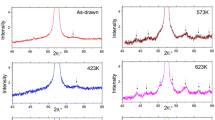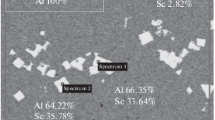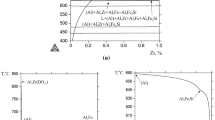Summary
Aluminum contains in lesser or larger amounts excess atoms, depending on the kind of mechanical or thermal treatment and on the concentration of trace impurities. The number of excess atoms in a 99.9 % pure recrystallized Al wire is 18 per 10 000 unit cells, and they may be a constituent of the denser segregations. The lattice constant of a cold drawn Al wire in the direction of its axis was slightly smaller (a 25=4.049 44) than that of the recrystallized wire (a 25=4.049 47 Å), but was larger in the transverse direction (a 25=4.049 63 Å). The thermal expansion coefficient of the recrystallized wire (α=22.9·10−6) between 10 and 60 °C did not differ (significantly) from that of the hard drawn wires. The density of the whole hard wire wasd 25=2.700 4 g/cm3 (core −2.698 9), that of the recrystallized wire was smaller (2.699 3 g/cm3). The concentration of interstitials was largest in the outside layers of the wire (at least 4 atoms per 1 000 unit cells or 1.5·1013 atoms per cm2). Previous measurements, giving lower densities for cold worked metals, may be explained by the fact that crack and capillary formation during cold work frequently outbalance the effect of density increase due to increase of interstitial atom (blocking dislocation) concentration, created by the process of slipping and deformation. Strain hardening appears then as a consequence of the increasing number of interstitial atoms. The latter processes are in agreement with the theories as discussed bySchmid andBoas. From the density decrease of the hard wire (after heating) the volume of submicroscopic fissures per cm3 was estimated: 10−4 cm3. They may be created by moving dislocations and vacancies (formation of dislocation cracks), during the deformation process. Only both, lattice constant and density measurements of the same material give a correct picture of conditions inside (in terms ofn′) of a deformed as well as of a recrystallized metal or another crystalline material.
Riassunto
L’alluminio contiene atomi in eccesso in maggiore o minore quantità, in dipendenza del genere di trattamento termico o meccanico e della concentrazione delle tracce di impurità. Il numero di atomi in eccesso in un filo di alluminio ricristallizzato puro al 99.9% è 18 su 10 000 celle unitarie, e questi atomi possono essere un costituente delle aggregazioni più dense. La costante reticolare di un filo di alluminio tirato a freddo era in direzione del suo asse leggermente minore (α 25=4.0494 Å) di quella di un filo ricristallizzato (α 25=4.049 47 Å), ma in direzione trasversale era maggiore (α25=4.049 63 Å). Il coefficiente di dilatazione termica del filo ricristallizzato (α=22.9·10−6) fra 10 e 16 °C non differiva (in maniera significativa) da quello dei fili trafilati temperati. La densità complessiva del filo temperato erad 25=2.700 4 g/cm3 (strato centrale −2.698 9), quella del filo ricristallizzato era minore (2.699 3 g/cm3). La concentrazione delle particelle interstiziali era maggiore negli strati esterni del filo (almeno 4 atomi ogni 1000 celle unitarie o 1.5·1013 atomi per cm2). Le misure precedenti, che davano densità inferiori per i metalli lavorati a freddo, possono essere spiegate dal fatto che la fessurazione e la formazione di cavità capillari durante la lavorazione a freddo spesso equilibrano l’effetto dell’aumento di densità dovuto all’aumento della concentrazione di atomi interstiziali (blocking dislocation), creato dal processo di scorrimento e deformazione. Lo « strain hardening » sembra dunque esser conseguenza del crescente numero di atomi interstiziali. Quest’ultimi processi sono in accordo con le teorie esposte daSchmid eBoas. Dalla diminuizione di densità del filo temperato (in seguito a riscaldamento) si stimò il volume di fessure submicroscopiche per cm3: 10−4 cm3. Queste possono essere create dallo spostarsi delle dislocazioni e vacanze (formazione di fessure per dislocazione) durante il processo di deformazione. Solo la costante reticolare e le misure di densità dello stesso materiale, danno un quadro corretto delle condizioni interne (in termini din′) di un metallo, od altro materiale cristallino, deformato oppure ricristallizzato.
Similar content being viewed by others
References
Seee.g. inG. Tammann:Metallkunde, 4-th Ed. (Leipzig, 1932), p. 169–172.
W. C. Burgers, inG. Masing:Handbuch der Metallphysik (Leipzig, 1940), vol.3, 2, p. 101.
J. S. Smart, A. A. Smith andJ. A. Philips:Am. Inst. M. M. Eng.,143, 272 (1941).
N. F. Mott:Proc. Roy. Soc., A220, 1 (1953).
A. N. Stroh:Phil. Mag.,2, 1 (1957).
M. E. Straumanis andY. N. Wang:Corrosion,12, 177, 181 (1956).
W. Boas: inDislocations and Mechanical Properties of Crystals,J. C. Fisher and Assoc. (New York, 1957), p. 342, 346.
J. L. Snoek:Phil. Mag.,41, 1188 (1950).
L. M. Clarebrough, M. E. Hargreaves andG. W. West:Phil. Mag.,1, 528 (1956), alsoProc. Roy. Soc., A232, 252 (1955).
M. E. Straumanis:Acta Cryst.,2, 83 (1949);Chimia,12, 136 (1958).
M. E. Straumanis:Phys. Rev.,92, 1155 (1953);95, 566 (1954).
H. P. Klug andL. E. Alexander:X-ray Diffraction Procedures (New York, 1954), p. 454.
M. Straumanis andA. Ievinš:Die Präzisionsbestimmung von Gitterkonstanten nach der asymmetrischen Methode (Berlin, 1940). Partial translation byK. E. Beu: Dept. of Commerce, Washington 25, D.C. (1959).
M. E. Straumanis:Journ. Appl. Phys.,20, 726 (1949).
M. E. Straumanis:Analyt. Chemistry,25, 700 (1952).
M. E. Straumanis:Rev. Scient. Instr.,22, 843 (1951).
M. E. Straumanis andC. H. Cheng:Inst. Metals,88, 287 (1959–60).
M. E. Straumanis:Zeits. f. Kristallogr.,104, 167, 173 (1942).
M. Straumanis:Acta Cryst.,8, 654 (1955).
J. B. Nelson andD. F. Riley:Proc. Phys. Soc.,57, 160 (1945).
L. V. Azároff andM. J. Buerger:The Powder Method (New York, 1958), p. 231, 238.
M. E. Straumanis:Journ. Appl. Phys.,30, 1965 (1959).
M. E. Straumanis:Amer. Mineralog.,38, 662 (1953).
Y. Beers:Theory of Error (Cambridge, Mass., 1953).
M. E. Straumanis:Chimia,12, 136, 140 (1958).
J. C. Blade, J. W. H. Clare andH. J. Lamb:Acta Met.,7, 136 (1959); see alsoJ. Calvet, J. J. Trillat andM. Paid:Compt. Rend. (1935), p. 426.
A. Ievinš andM. Straumanis:Zeits. Physik. Chem., B34, 402 (1936).
M. E. Straumanis andT. Ejima:Journ. Chem. Phys.,32, 629 (1960).
M. E. Straumanis andT. Ejima:Zeits. Physik. Chemie,23, 440 (1960).
B. F. Figgins, G. O. Jones andD. P. Riley:Phil. Mag.,1, 747, 754 Tab. III (1956).
E. R. Jette andF. Foote:Journ. Chem. Phys.,3, 605 (1935).
A. J. C. Wilson:Proc. Phys. Soc.,53, 235 (1941).
H. J. Axon andW. Hume-Rothery:Proc. Roy. Soc., A193, 1 (1948).
C. G. Maier:Trans. AIME,122, 121 (1936).
T. M. Lowry andR. G. Parker:Journ. Chem. Soc. Tr.,107, 1005, 1013, 1018 (1915).
M. Straumanis:Zeits. f. Phys.,49, 55 (1949).
A. Smakula, J. Kalnajs andV. Sils:Phys. Rev.,99, 1747 (1955).
R. B. Hill andH. J. Axon:Research Corr.,6, 235 (1953).
U. Dehlinger:Zeits. Krist.,75, 241 (1930).
E. A. Owen, Y. H. Liu andD. P. Morris:Phil. Mag., (7)39, 831 (1948).
S. L. Smith andW. A. Wood:Proc. Roy. Soc. (Lond.),182, 404 (1944).
See alsoC. S. Barrett:Structure of Metals (New York, 1952), p. 431, 443.
C. Crussard andF. Aubertin:Rev. Metall.,46, 354 (1949).
G. B. Greenough:Progr. Metal Phys.,3, 176 (1952);Nature,160, 258 (1947).
A. R. Rosenfield andB. L. Averbach:Journ. Appl. Phys.,47, 154 (1956).
Dr.A. Niggli (Zürich, E.T.H.) suggested a rhombohedral deformation of the cubic cell. However, the calculated number of atoms per unit cell was the same within the limits of error.
A. L. Titchener andM. B. Bever:Progr. Metal Phys.,7, 247, 322 (1958).
M. E. Straumanis:Zeits. Kristallogr., (A)83, 29 (1932).
E. Schmid andW. Boas:Kristallplastizität (Berlin, 1935); English ed. (London, 1950).
W. Boas:Physics of Metals and Alloys (New York, 1949), p. 131, 132.
P. B. Hirsch:Progr. Metal Phys.,6, 236, 252, 292 (1956). See also various places inJ. C. Fisher and Assoc.:Dislocations and Mechanical Properties of Crystals (New York, 1956).
G. I. Taylor:Proc. Roy. Soc., A145, 362, 388 (1934).
A. Seeger andP. Haasen:Phil. Mag., (8),3, 470 (1958).
W. M. Lomer:Phil. Mag., (8),2, 1053 (1957).
Seee.g. J. Harwood inW. D. Robertson:Stress Corrosion Cracking (New York, 1956), p. 9.
G. Tamman andH. Bredemeier:Zeits. anorg. allgem. Chem.,142, 54 (1925).
W. A. Wood:Phil. Mag., (8),3, 692 (1958).
F. Seitz:Advanc. Physics,1, 43 (1952).
J. W. Allen:Phil. Mag.,4, 1406 (1959).
A. S. Keh, J. C. N. Li andT. T. Chou:Acta Met.,7, 694 (1959).
Seee.g. G. Tamman andC. L. Wilson:Zeits. anorg. allgem. Chem.,173, 156 (1928).
Seee.g. W. M. Lomer:Progr. Metal Phys.,8, 255, 289 (1959).
A. W. Lawson:Progr. Metal Phys.,6, 1 (1956).
H. R. Pfeiffer:Journ. Appl. Phys.,29, 1581 (1958).
G. Tamman andM. Straumanis:Zeits. anorg. allgem. Chem.,169, 365 (1928).
F. B. Cuff andN. J. Grant:Journ. Inst. Metals,87, 248 (1958–59).
Author information
Authors and Affiliations
Additional information
Presented in part byM. E. Straumanis at the University of Rome on April 14 1958, under the title:Imperfezioni nell’alluminio ricristallizzato e lavorato a freddo e incrudimento.
The present investigation was sponsored by National Science Foundation under the contract 2099-g-2585.
Rights and permissions
About this article
Cite this article
Straumanis, M.E., Ejima, T. Imperfections, lattice constants and densities of cold-drawn and of recrystallized aluminium wires. Nuovo Cim 18 (Suppl 1), 48–64 (1960). https://doi.org/10.1007/BF02726037
Received:
Published:
Issue Date:
DOI: https://doi.org/10.1007/BF02726037




